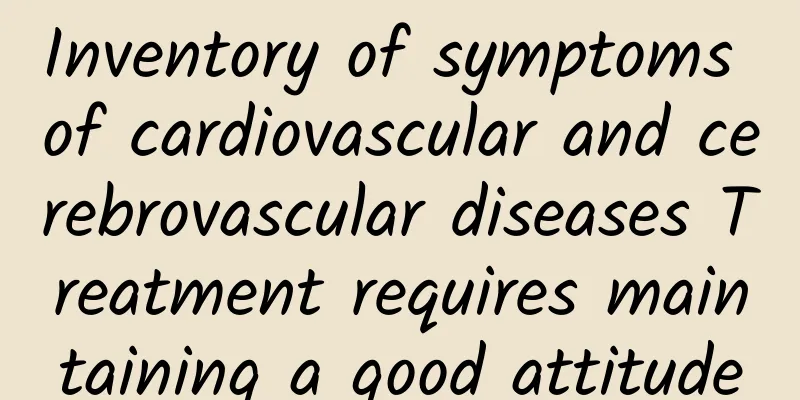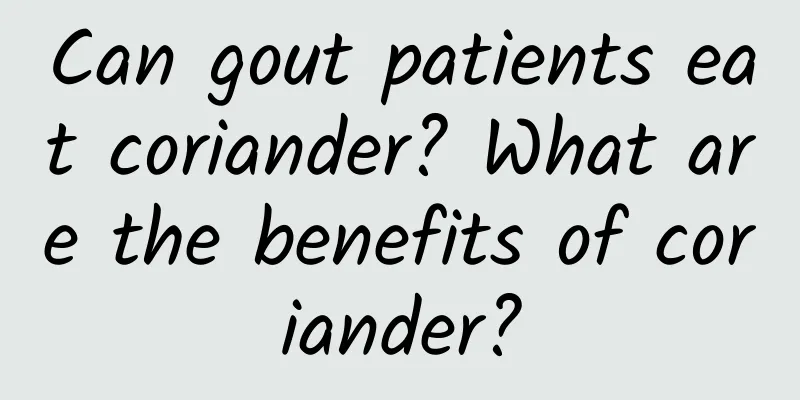Inventory of symptoms of cardiovascular and cerebrovascular diseases Treatment requires maintaining a good attitude

|
Cardiovascular disease does not refer to a single type of disease. Medically, cardiovascular disease mainly includes two types, namely cardiovascular and cerebrovascular diseases. This type of disease can seriously endanger human health, especially in middle-aged people. So, what are the clinical symptoms of cardiovascular disease? Clinical manifestations 1. Cardiovascular disease Common symptoms of cardiovascular disease include: palpitations, shortness of breath, orthopnea, nocturnal paroxysmal dyspnea, compressive or tight pain behind the sternum, chest tightness, edema, cyanosis, syncope, coughing and hemoptysis, weakness, belching, upper abdominal pain, nausea, vomiting; left back pain, left arm pain, etc. 2. Cerebrovascular disease There may be hemiplegia, hemisensory disorder, hemianopsia, aphasia; or crossed paralysis, crossed sensory disorder, external ophthalmoplegia, nystagmus, dysphagia, ataxia, vertigo, etc.; or limb weakness, numbness, sensory disorders of the face, upper and lower limbs; inflexible limb movement on one side; language disorder, incoherent speech; decreased memory; sudden difficulty in seeing objects clearly; or inflexible eye movement; urinary incontinence; imbalance of balance, unstable standing; consciousness disorder; headache or nausea and vomiting; dizziness, tinnitus, etc. treatment 1. Keep a balanced mindset Patients with coronary heart disease and hyperlipidemia should especially be more open-minded and not let their emotions fluctuate too much. 2. Appropriate exercise Cardiovascular and cerebrovascular patients should exercise appropriately. Reduced exercise will also cause slow blood flow and increased blood lipids. Exercise time should be arranged reasonably and the amount of exercise should be controlled. In winter, exercise should be done after the sun rises. At this time, the temperature rises, which can prevent the body from being suddenly stimulated by cold and causing illness. 3. Control risk factors Strictly control blood pressure to an ideal level, take effective lipid-lowering drugs, control diabetes, improve insulin resistance and abnormal metabolic status, and quit smoking. 4. Drug treatment Depending on the different cardiovascular and cerebrovascular diseases, targeted therapeutic drugs are given to relieve symptoms, improve prognosis and prevent complications. 5. Surgical treatment Through surgery or interventional treatment, bleeding can be stopped, hematoma can be eliminated, or blood supply to ischemic areas can be improved. 6. Rehabilitation therapy After the patient's condition stabilizes, they will start with simple passive exercises, gradually move on to active exercises, and eventually achieve the goal of taking care of themselves. Early rehabilitation training is particularly important for the functional recovery of patients with cerebrovascular diseases. |
<<: If a man feels stinging pain in his urethra when urinating, be careful of gonorrhea!
>>: Is it effective for men to take birth control pills? What is the best contraceptive method?
Recommend
What are the hazards of non-gonococcal urethritis in men
Everyone should have come into contact with non-g...
What causes yellow semen and a strange odor?
In daily life, many male friends are under increa...
What is the best way for boys to lose weight through exercise?
Although the nutrients and calories absorbed by b...
What is the method to replenish kidney essence?
Many men suffer from kidney deficiency because of...
What are the causes of urethral discharge in men?
If a man has purulent discharge during normal uri...
Can warts grow on the glans penis?
The glans is a very critical part of the male pen...
Men can improve their sexual performance by eating scallions three times a week
Chinese people pay attention to diet and health p...
Can men practice yoga to lose weight?
When talking about yoga, I believe that many frie...
How to train upper chest muscles? Five exercises to build a "chest muscle man"
Perhaps due to the influence of innate conditions...
What is the normal color of a man's sperm?
Sperm is an important substance for male reproduc...
Causes of back pain in men
In fact, in daily life, male friends are under gr...
How to make ginger soup to dispel cold and what are its effects
In the past, when medicine was not well developed...
How to take care of the redness of the scrotum without itching?
The redness of the scrotum without itching is mai...
What medicine should men take if they sweat while sleeping?
Good sleep quality is what everyone needs, but no...
What are the symptoms of spondylitis? Causes of spinal pain
The spine, lumbar spine, and cervical spine may a...









